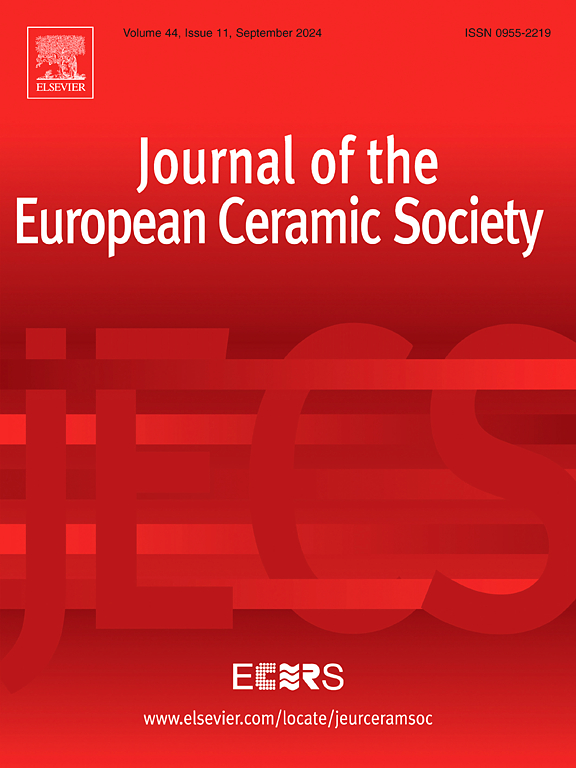Enhanced gyromagnetic properties and loss reduction of highly-dense NiCuZn ferrite for millimeter-wave applications
IF 5.8
2区 材料科学
Q1 MATERIALS SCIENCE, CERAMICS
Journal of The European Ceramic Society
Pub Date : 2025-04-26
DOI:10.1016/j.jeurceramsoc.2025.117484
引用次数: 0
Abstract
Prior studies predominantly utilized solid-state sintering to fabricate Ni-based ferrite ceramics, aiming to enhance magnetic properties. While some researchers have adopted the hot-pressing method for preparing these ceramics, the resultant porosity remained elevated (>2 %), leading to an increased ferromagnetic resonance linewidth (ΔH). The impact of high temperature and pressure during the forming process on ΔH and gyromagnetic properties in nickel-based ferrite ceramics has been seldom explored using hot pressing. Building on prior research involving solid-state sintering of Ni-based ferrite, this study employed a vacuum hot-pressing sintering technique to further optimize the gyromagnetic properties of the ferrite. A systematic investigation was conducted to understand the influence of porosity, grain size, and microstructure on the magnetic attributes of Ni ferrite ceramics. Under conditions of high pressure (48 MPa) and zero holding time, as the hot-pressing sintering temperature rose from 800°C to 1050°C, the average grain size expanded from 0.4 μm to 3.36μm. Concurrently, the relative density and saturation magnetization initially increased before decreasing. Consequently, a NiCuZn ferrite characterized by uniform, dense grains (GSave=1.94 μm and Dr=99.2 %) and good gyromagnetic properties (4πMs=4703 Gs and ΔH=277 Oe) was achieved through hot-pressure sintering at approximately 950°C.
用于毫米波应用的高密度NiCuZn铁氧体的增强陀螺磁性能和降低损耗
以往的研究主要是利用固态烧结技术制备镍基铁氧体陶瓷,以提高其磁性能。虽然一些研究人员采用热压方法制备这些陶瓷,但由此产生的孔隙率仍然很高(>2 %),导致铁磁共振线宽增加(ΔH)。高温高压成形过程中对镍基铁氧体陶瓷ΔH和陀螺磁性能的影响,目前很少采用热压技术研究。在ni基铁氧体固态烧结研究的基础上,本研究采用真空热压烧结技术进一步优化了铁氧体的回旋磁性能。研究了孔隙率、晶粒尺寸和微观结构对Ni铁氧体陶瓷磁性能的影响。在高压(48 MPa)和零保温条件下,随着热压烧结温度从800℃升高到1050℃,平均晶粒尺寸从0.4 μm扩大到3.36μm。相对密度和饱和磁化强度先增大后减小。结果表明,在950℃左右的高温下烧结得到了晶粒均匀致密的NiCuZn铁氧体(GSave=1.94 μm, Dr=99.2 %)和良好的旋磁性能(4πMs=4703 Gs, ΔH=277 Oe)。
本文章由计算机程序翻译,如有差异,请以英文原文为准。
求助全文
约1分钟内获得全文
求助全文
来源期刊

Journal of The European Ceramic Society
工程技术-材料科学:硅酸盐
CiteScore
10.70
自引率
12.30%
发文量
863
审稿时长
35 days
期刊介绍:
The Journal of the European Ceramic Society publishes the results of original research and reviews relating to ceramic materials. Papers of either an experimental or theoretical character will be welcomed on a fully international basis. The emphasis is on novel generic science concerning the relationships between processing, microstructure and properties of polycrystalline ceramics consolidated at high temperature. Papers may relate to any of the conventional categories of ceramic: structural, functional, traditional or composite. The central objective is to sustain a high standard of research quality by means of appropriate reviewing procedures.
 求助内容:
求助内容: 应助结果提醒方式:
应助结果提醒方式:


